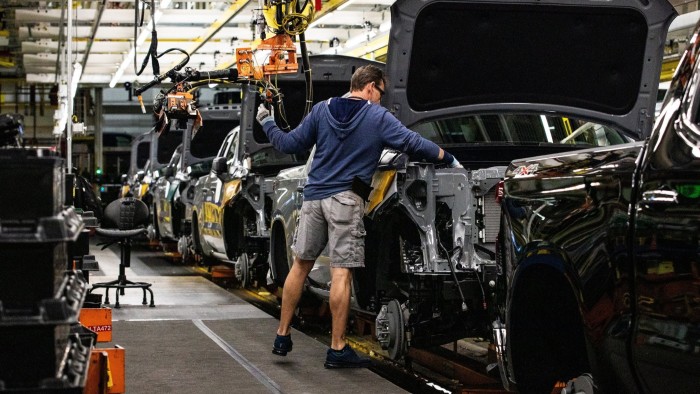This article is an on-site version of Free Lunch newsletter. Premium subscribers can sign up here to get the newsletter delivered every Thursday and Sunday. Standard subscribers can upgrade to Premium here, or explore all FT newsletters
Greetings — Free Lunch hopes all readers had a restful break over the weekend, whether or not you celebrated Easter. The passing of Pope Francis (see our editorial here) has drawn attention to the Vatican, where world leaders will soon gather for the funeral. So it is a good time to adapt the Vatican practice of giving the devil an advocate in canonisation proceedings to the arguments around President Donald Trump’s tariffs. For a lot more people than those who support Trump are taking a “no, but” attitude, thinking the White House has a point even if they don’t like the way it is going about things. Below, I probe this broad sympathy for trying to force the US trade deficit down.
There are possible motivations for Trump’s trade war policymaking that I will mention only to leave them aside. One is that tariffs may be purely instrumental: a tool to create “leverage” — ie to bully other countries into changing unrelated policies (paying more for their own defence, for example). The other relates to the confused thinking about the role of the US dollar, well reported by my colleague Gillian Tett. I say “confused” because it’s not even clear if the goal is to make the dollar more attractive (to improve the terms of trade and get cheaper borrowing) or less attractive (to discourage imports and protect domestic industry). In any case, neither of these has anything to do with the economic effects of tariffs, which is what I want to focus on here.
Instead, I want to highlight one very explicit goal the tariff policy seems designed to pursue: reduce the US trade deficit overall and even each bilateral deficit separately. This is as good an assumption as any about what motivates the White House, especially since it’s the stated justification for the bizarre choice of the now-suspended “reciprocal” tariff structure. The derivation of those bilateral tariffs was rankly incompetent, but it was instructive that the intention was “computing the tariff level consistent with driving bilateral trade deficits to zero”. The call for “balanced trade”, ie zero net surpluses and deficits, was made again by Treasury secretary Scott Bessent during this week’s World Bank-IMF meetings in Washington.
And this is where it gets interesting, since a lot of people, including commentators far beyond the Maga ranks, and on the left as well as on the right, share the view that it is vital to reduce the US’s trade deficit. Some of my best friends are people who think that! (Sorry.)
Start with Michael Pettis, co-author of the influential book Trade Wars Are Class Wars, who thinks, like the Trump administration, that it is a fundamental problem that some countries have surplus exports:
. . . global economic imbalances are real. The challenge is not whether the US should act to correct these imbalances, but rather how it should do so in a way that is both effective and sustainable. The best solution lies in a more co-ordinated approach to global economic governance . . . if the world is unable to come to such an agreement, the US is justified in acting unilaterally to reverse its role in accommodating policy distortions abroad . . .
Why is it a problem that some countries have surpluses that supposedly “force” others to have deficits? Why, in particular, are the current asymmetries unsustainable? There is a worry about accumulating debts to foreigners if you run constant external deficits, but the current level of the US current account — just over 3 per cent of GDP — should not be unsustainable for an economy that can count on nominal growth of 4 per cent over the long term and enjoys global reserve currency status (if it can keep it).
Instead, what Trump and his team most dislike about the deficit is that it has depressed US manufacturing, or so they think. And so do many others, including Pettis.
Matthew Klein, Pettis’s co-author of Trade Wars, and a friend and former FT colleague, recently presented a “principled case for an American industrial renaissance” in his excellent newsletter:
It is reasonable to care about American manufacturing . . . American manufacturing has been in a funk for 25 years . . . This is not normal, and it is not benign . . . These are serious problems that threaten both American prosperity and US national security. We live in the physical world, and historically, economy-wide productivity gains and technological innovations have been disproportionately attributable to manufacturing improvements rather than the services sector.
Klein’s arguments relate to industrial output — how much stuff America manages to produce for itself. Again, there may be different reasons to care about this. One is resilience versus dependence on geopolitical adversaries — but that has more to do with the gross production of specific products, not “balanced trade” in manufacturing overall. One might care about the general level of US manufacturing capacity, which has stagnated since 2008.
But the most common answer is that what matters are jobs. Oren Cass and the American Compass think-tank are friends — but critical friends — of the Trump administration’s economic policy efforts, and perhaps the most eloquent defenders of interventionist, protectionist economic policy tools in the aid of conservative goals. They, too, advance the claim that trade deficits hurt manufacturing, but focus mostly on the loss of factory jobs, which hurts local communities that used to depend on them. (There is an excellent paper on the localised job loss effect of import penetration by David Autor, David Dorn and Gordon Hanson.)
Cass defends US commerce secretary Howard Lutnick (against my Free Lunch co-conspirator Tej Parikh, who wrote a recent piece on US manufacturing) on whether we should welcome factory jobs with falling productivity — which is just what the US has been getting in the past 15 years, though I haven’t heard any of the tariff advocates applaud this.
Lutnick is making an important point here, which is that reshoring labor-intensive manufacturing from abroad does not mean doing it in a labor-intensive way here; the jobs in the United States would be much better and more productive ones requiring more skills in more capital-intensive and automated factories . . . If we had highly productive jobs in factories, didn’t have as many people working in the factories, but they were anchoring local economies, they were anchoring supply chains, they were providing better jobs in those towns in services, I think that would be a terrific outcome. That’s exactly the outcome we should be looking for.
I have distinguished these three writers by their main focus — the deficit, industrial output and factory jobs — in an admittedly artificial way. In truth, I take them all as belonging to a camp that cares about all three and generally endorses some version of a trade-to-manufacturing causal relationship that roughly says trade deficits shrink domestic industry, which in turn reduces the number of factory jobs.
But I think it’s useful to separate out the three aspects because, too often, they are run together as a matter of course. As it turns out, we should not take the implied causal connections at face value.
Start with manufacturing. What is it that you want: greater production or greater employment? It’s not at all clear that the two go together. At least they haven’t in the US for the past 50 years, as the chart below shows. It shows that factory jobs fell for three decades from 1979 (with fluctuations around the business cycle), but actual industrial production kept expanding.
By definition, then, labour productivity kept rising. Until the 2008 financial crisis, that is. Since then, the economy has been stuck below a ceiling of industrial output (and productive capacity), but has slowly been adding factory jobs. Productivity, therefore, has been slowly declining.
What this shows is that pursuing factory production and pursuing factory jobs are not at all the same thing. It’s true that something changed in the global financial crisis that stopped the previous trend. Between 2010 and 2022, the US added a net 1.4mn factory jobs. That contributed precisely nothing to additional industrial production. Was this a victory? If the fortunes of post-industrial towns were turned around, that doesn’t seem to have mitigated the frustrations that powered Trump’s rise to power. And if you care about national security and resilience, might it not have been better if the pre-2008 trends had continued, with ever-rising industrial output, albeit produced with ever fewer hands?
And now return to the deficit. Given that output and jobs are not straightforwardly related, what is it we are supposed to expect balanced trade to deliver? The growth in output before 2008 was steady against a wildly oscillating deficit. After that, the current account hovered between negative 2 and 3 per cent of GDP for a decade, much less than in the mid to late 2000s. So did a smaller but still large trade deficit contribute to the factory jobs growth that followed? Why did industrial production stagnate just as the trade deficit moderated and stabilised? It’s not at all clear what the mechanism here is supposed to be.
Indeed, the facts invite quite a different interpretation. This is that the causality goes from manufacturing to external balance rather than the other way round. If you produce a lot of manufactures, you are likely to have a surplus (because you can’t consume it all yourself), rather than the other way around. On this view, the success of manufacturing depends a lot more on domestically oriented policies — financing conditions, expectations of domestic demand growth, geographical labour mobility and subsidies — than on trade policy. Most of these domestic conditions discouraged capital investment in manufacturing in the post-2008 US.
This story seems to me to make more sense of the US numbers as well as comparisons with the rest of the world — where manufacturing jobs shares are in secular decline in all rich economies, whether in surplus or in deficit. If so, Trump and his more or less critical sympathisers may just be putting the cart before the horse, with as little chance of progress.
Other readables
Recommended newsletters for you
Chris Giles on Central Banks — Your essential guide to money, interest rates, inflation and what central banks are thinking. Sign up here
India Business Briefing — The Indian professional’s must-read on business and policy in the world’s fastest-growing large economy. Sign up here





